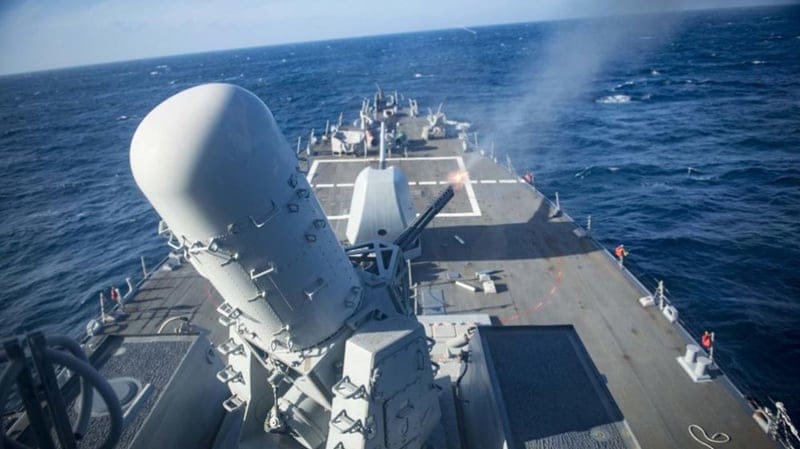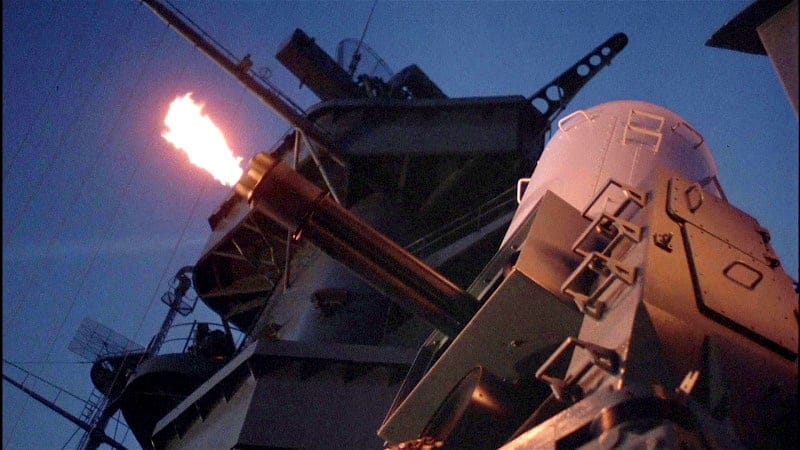For much of naval history, warships had to close in on the enemy during combat. It wasn’t until the Battle of the Coral Sea in 1942 that opposing ships ever took part in fights beyond visual range. However, in today’s warfare, if you can spot the enemy approaching, it is probably already too late.
On January 30, 2024, a Houthi anti-ship cruise missile came within a mile of the United States Navy’s Arleigh Burke-class destroyer USS Gravely (DDG-107) – mere seconds from striking the warship. Fortunately, the Phalanx Close-in Weapon System (CIWS) was able to destroy the missile in flight.
“On Jan. 30, at approximately 11:30 p.m. (Sanaa time), Iranian-backed Houthi militants fired one anti-ship cruise missile from Houthi-controlled areas of Yemen toward the Red Sea. The missile was shot down by USS Gravely (DDG 107). There were no injuries or damage reported,” the United States Central Command (@CENTCOM) announced via a post on X, the social media platform known as Twitter.

It marked the first use in the ongoing conflict of the system that has been rightfully described as the U.S. Navy’s “last line of defense.”
Way Too Close For Comfort
It remains unclear why the ESSM or other longer-range air defense systems weren’t employed during the January 30 Houthi strike, but the Phalanx was employed just as it was designed to do.
It was also arguably a more cost-effective solution, as the air defense missiles employed by the U.S. and Royal Navies – such as the RIM-162 Evolved Sea Sparrow Missile (ESSM) – cost upwards of $2 million each. However, the ESSM can strike anti-ship missiles from significantly greater distances, and given the potential loss of life, a layered defense is required. The sailors don’t want to count on the Phalanx CIWS, but they were likely pleased with its recent results.
Much More Than Modern Gatling Gun
It would be easy to compare the automated Phalanx system to a Gatling gun, as it is based on the 20mm M61 Vulcan autocannon. It can fire 20mm x 102mm rounds at an extremely high rate – with a dual fire rate of either 3,000 or 4,500 rounds per minute – and engage projectiles or other targets at extremely close range.

It is pneumatically driven and can be employed against anti-ship missiles, aircraft, and even maneuvering sea-skimmers or fast-moving small boats.
“At sea, navies use Phalanx to defeat anti-ship missiles and close-in threats that have pierced other lines of defense. On land, the U.S. Army uses the weapon system to detect and counter rocket, artillery, and mortar systems,” Raytheon, the manufacturer of the platform, explained on its website.
The Phalanx weapon system is currently installed on all U.S. Navy surface combatant ship classes, as well as those of 24 allied nations, while the land-based version (LPWS) is forward deployed and has been used in combat. The CWIS (often known as the “C-Wiz” by its operators) was developed to carry out functions usually performed by multiple systems, including search, detection, threat evaluation, tracking, engagement, and kill assessment.
Due to its unique domed shape, the system also earned the nickname “R2-D2,” a reference to the feisty little droid from the Star Wars films.
Development of the CIWS
The first prototype of what was to be the CIWS began in the early 1970s, and it was initially tested on the guided missile destroyer leader USS King (DLG-10) – later redesignated a guided missile destroyer as DDG-41. However, it was determined the system required a few more years of testing, which was conducted on the destroyer USS Bigelow (DD-942), with the mount being installed just aft of the aft radar gun director.
It exceeded operational maintenance, reliability, and availability specifications, and was approved for adoption by the sea service. Production of the Phalanx CIWS began in 1978 with the Block 0 configuration, and it was first installed in 1980 on the U.S. Navy’s aircraft carrier USS Coral Sea.
It has remained in active and continuous production, upgrade, and overhaul programs since 1978.

It was first upgraded with the Block 1 configuration, which offered various improvements in radar, ammunition, computing power, and rate of fire, as well as an increase in maximum engagement elevation to +70 degrees. Those improvements, which were made at the tail-end of the Cold War, were intended to increase the system’s capability against emerging Soviet supersonic anti-ship missiles. The enhanced Block 1 was first installed on World War II Iowa-class battleship USS Wisconsin in 1988.
The subsequent Block 1A introduced a new computer system to counter more maneuverable targets.
The Phalanx Block 1B
The current Phalanx variant (Block 1B) has added the ability to counter asymmetric warfare threats through the addition of an integrated, stabilized, Electro Optic sensor. In addition, the latest improvements further provide Phalanx the additional ability to counter small high-speed surface craft, aircraft, helicopters, and unmanned aerial systems (UAS).
The Phalanx remains the only deployed close-in weapon system capable of autonomously performing its own search, detect, evaluation, track, engage, and kill assessment functions. It also can be integrated into existing ship combat control systems to provide additional sensor and fire-control support to other installed ship weapon systems. The Block 1B was installed aboard USS Underwood (FFG-36) in 1999.
Ground-based Defense: The Centurion
Though the Phalanx was initially developed for use on warships, the United States Army also utilized a modified version as part of its Counter-Rocket, Artillery, Mortar (C-RAM) program. Dubbed the “Centurion,” it was first deployed to Iraq in 2005 to protect forward operating bases and high-value sites around Baghdad’s Green Zone.

Each system consisted of a modified Phalanx 1B CIWS, powered by an attached generator and mounted on a trailer for mobility. In January 2021, the C-RAM system was used to shoot down drones targeting a compound at Baghdad airport. While the naval-based Phalanx systems typically fire tungsten armor-piercing rounds, the C-RAM employs the 20mm HEIT-SD (High-Explosive Incendiary Tracer, Self-Destruct) ammunition, originally developed for the M163 Vulcan Air Defense System. Those latter rounds explode if they impact a target but self-destruct on tracer burnout if they miss, which greatly reduces the risk of collateral damage on the ground.
In 2022, Ukraine formally requested that the United States supply the C-RAM to help counter-drone and missile attacks on Kyiv and other urban centers.
The CIWS in Popular Culture
In April 2023, the Battleship Missouri Memorial unveiled a new exhibit on the now-retired warship that focused on the Phalanx. It noted that as part of the 1986 re-commissioning of the USS Missouri (BB-63), the Iowa-class battle wagon also received the Mark 15 Phalanx CIWS. Time had not been kind to the weapon, and it took a reported 750 volunteer hours to completely restore the M51A1 Vulcan autocannon.
Control of the Mighty Mo’s CIWS was directed from the Combat Engagement Center (CEC), and four CIWS mounts provided the ship with a 360-degree area of protection.

That point should be noteworthy to any fans of the 1991 film “Under Siege” starring Steven Segal and Tommy Lee Jones – as the Phalanx is employed to shoot down a U.S. Navy F/A-18 Hornet. However, as the former South Dakota-class battleship USS Alabama (BB-60) – now also a museum ship – stood in for USS Missouri, a prop version had to be produced. BB-60 was retired in 1947 and never received the upgraded weapon.


